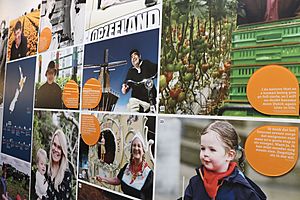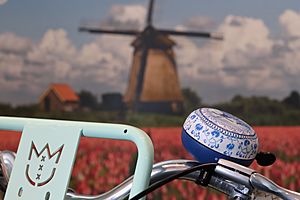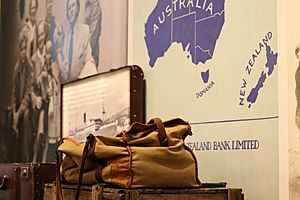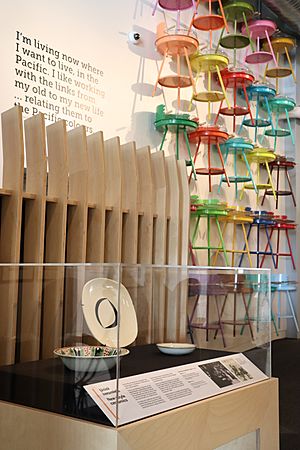Oranjehof facts for kids
 |
|
| Location | 92 Main Street, Foxton, New Zealand |
|---|---|
Oranjehof is a cool museum in Foxton, New Zealand. It's part of a bigger place called Te Awahou Nieuwe Stroom, which is a community hub for everyone. This hub is about an hour's drive north of Wellington.
Te Awahou Nieuwe Stroom is a special place. It also has the Piriharakeke Generation Inspiration Centre, a library, and rooms for community events. You can find a gallery, a heritage room, and a Council Service Centre there too. There's even an i-SITE desk to help visitors.
The Oranjehof museum was created with lots of help from the Dutch community in New Zealand. It's a place to learn about Dutch culture, language, and the stories of Dutch people who came to New Zealand. Oranjehof is a key part of the Te Awahou Riverside Cultural Park. This park also has two Dutch-inspired cafes and a flour-grinding windmill called De Molen.
The Dutch Connection Museum Trust worked together with the Horowhenua District Council and the Te Taitoa Māori o Te Awahou Trust. They all helped create the Te Awahou Nieuwe Stroom facility, which is home to the Oranjehof Dutch Connection Centre.
Contents
Discover the Oranjehof Museum
Oranjehof is designed in a cozy, Dutch style, known as gezelligheid. You can see art by famous Dutch artists here. These include photographer Ans Westra, sculptor Leon van den Eijkel, and ceramic artists Anneke Borren and Melis van der Sluis. There are also designs by fashion icon Doris de Pont and Carpay, who made amazing work for Crown Lynn and influenced textile and graphic design.
Explore Dutch History and Culture
The museum shows how the Dutch have influenced New Zealand. For example, the country's name comes from the arrival of Abel Tasman in 1642. This was 127 years before Captain Cook! It was the first time Europeans met the Māori people.
Since the 1950s and 1960s, Dutch immigrants and their families helped make New Zealand a more diverse country. Many Dutch families started speaking English at home and blended into society. Because of this, they were sometimes called the 'Invisible Immigrants'.
Oranjehof helps keep this Dutch heritage alive. It shares their history, special items, art, language, and culture. It's a central place for the Dutch community in New Zealand. About one in every 40 New Zealanders has some Dutch family background or connections.
The museum tells these interesting stories using interactive digital displays.
At Oranjehof, you can learn about:
- Tasman's Journeys: The first meeting between Māori and European cultures.
- Why Dutch People Came: The reasons why many Dutch people moved to New Zealand.
- Dutch Influence on Art: How Dutch art and design shaped New Zealand.
- Food and Farming: The origins of foods like Vogel's bread and Verkerks salami. Also, how the Dutch influenced coffee culture, cheese making (like Gouda and Edam), and farming.
- Dutch Language: You can listen to Dutch radio and hear the language.
- Traditional Games: Play old Dutch games and even dress up for fun photos!
Visit De Molen Windmill
De Molen is a full-size copy of a Dutch windmill. It was finished and opened in 2003. This windmill is a great example of teamwork between the Netherlands and New Zealand. Its gears, millstones, and sails were made and put in place by a company from the Netherlands. Many volunteers helped build the mill, led by local builder Cor Slobbe.
The windmill's design is from the 17th century, with impressive wooden beams. When it's windy, you can hear the mill creaking as its parts move. It grinds flour on windy days! The mill had some big repairs in 2018.
De Molen is a working windmill that makes stone-ground flour. You can buy this flour inside the mill's Dutch Deli. Visitors can climb up three floors to see the wooden machinery working. It's a great way to see 17th-century Dutch engineering in action. On windy days, the miller sets the blades moving. They can also give tours and explain the history of milling.
Images for kids







